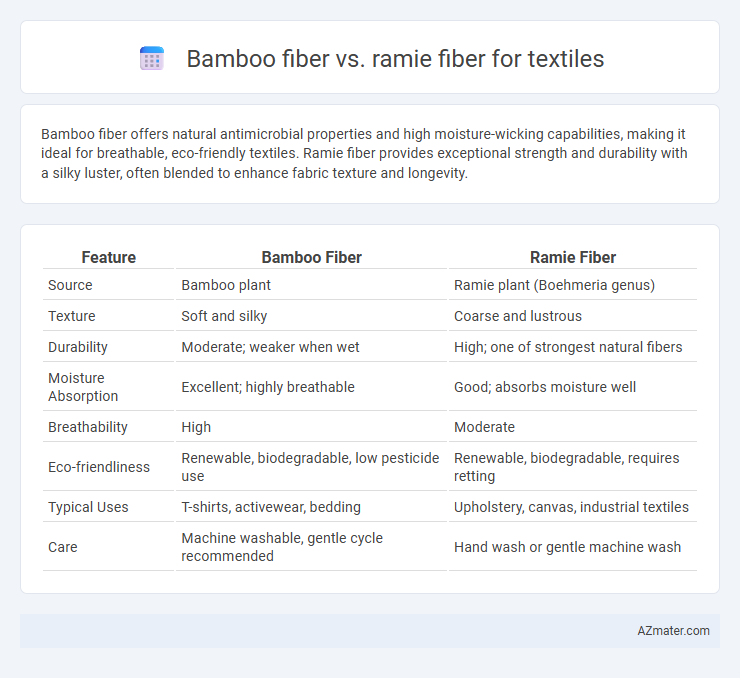Bamboo fiber offers natural antimicrobial properties and high moisture-wicking capabilities, making it ideal for breathable, eco-friendly textiles. Ramie fiber provides exceptional strength and durability with a silky luster, often blended to enhance fabric texture and longevity.
Table of Comparison
| Feature | Bamboo Fiber | Ramie Fiber |
|---|---|---|
| Source | Bamboo plant | Ramie plant (Boehmeria genus) |
| Texture | Soft and silky | Coarse and lustrous |
| Durability | Moderate; weaker when wet | High; one of strongest natural fibers |
| Moisture Absorption | Excellent; highly breathable | Good; absorbs moisture well |
| Breathability | High | Moderate |
| Eco-friendliness | Renewable, biodegradable, low pesticide use | Renewable, biodegradable, requires retting |
| Typical Uses | T-shirts, activewear, bedding | Upholstery, canvas, industrial textiles |
| Care | Machine washable, gentle cycle recommended | Hand wash or gentle machine wash |
Introduction to Bamboo and Ramie Fibers
Bamboo fiber is a sustainable textile material derived from the pulp of bamboo grass, known for its natural antibacterial properties, moisture-wicking ability, and biodegradability. Ramie fiber, extracted from the stalks of the Ramie plant (Boehmeria nivea), is one of the oldest natural fibers used in textiles, prized for its exceptional strength, lustrous appearance, and resistance to wrinkling. Both fibers are eco-friendly alternatives in the textile industry, offering unique benefits in softness, durability, and environmental impact.
Botanical Origins and Cultivation
Bamboo fiber is derived from the fast-growing bamboo plant belonging to the Poaceae family, cultivated extensively in Asia's subtropical and tropical regions for its rapid renewability and high biomass yield. Ramie fiber, sourced from the stalks of the Ramie plant (Boehmeria nivea) of the Urticaceae family, thrives in moist, warm climates primarily across China, Brazil, and the Philippines, requiring less pesticide use due to its natural resistance to pests. Both fibers rely on sustainable cultivation practices, but bamboo's impressive growth rate offers a more environmentally efficient raw material for textiles compared to ramie's labor-intensive retting and harvesting process.
Fiber Extraction Processes
Bamboo fiber extraction involves mechanical processing or chemical treatments such as alkaline and bleaching processes to separate cellulose fibers from bamboo stalks, often producing viscose rayon from bamboo. Ramie fiber extraction primarily relies on degumming processes where the gummy latex substances are removed by soaking and boiling in alkaline solutions, preserving the long, fine bast fibers ideal for textile use. Mechanical extraction in ramie is labor-intensive but yields strong, lustrous fibers, while bamboo's chemical treatments facilitate mass production but may impact environmental sustainability.
Physical Properties Comparison
Bamboo fiber exhibits excellent moisture-wicking ability and superior softness, making it ideal for breathable, comfortable textiles, while ramie fiber has high tensile strength and good durability due to its crystalline cellulose structure. Bamboo fiber's density ranges from 1.0 to 1.5 g/cm3, contributing to lightweight fabrics, whereas ramie fiber typically has a density around 1.5 g/cm3, offering sturdier, more abrasion-resistant materials. Both fibers show high moisture regain, with bamboo averaging 11-13% and ramie slightly higher at 12-13.5%, enhancing textile breathability and comfort.
Environmental Impact and Sustainability
Bamboo fiber is highly valued in textiles for its rapid growth, requiring minimal water and pesticides, which significantly reduces its environmental footprint compared to traditional crops. Ramie fiber, derived from the Boehmeria plant, offers strong durability and biodegradability but involves chemical-intensive processing that can challenge sustainability efforts. Both fibers contribute to eco-friendly textiles, yet bamboo's lower water usage and natural antibacterial properties make it a more sustainable choice in reducing environmental impact.
Moisture Absorption and Breathability
Bamboo fiber exhibits superior moisture absorption properties, capable of absorbing up to 40% of its weight in moisture, which enhances its breathability and comfort in textile applications. Ramie fiber also provides good breathability but has lower moisture absorption, typically around 12%, making it less effective at wicking sweat compared to bamboo. Due to its high moisture management and breathability, bamboo fiber is often preferred for activewear and summer clothing over ramie.
Durability and Strength Differences
Bamboo fiber demonstrates moderate durability with a tensile strength ranging between 2.5 to 3.0 grams per denier, making it suitable for lightweight textiles but prone to wear over time. Ramie fiber exhibits superior strength, with a tensile strength of approximately 4.7 grams per denier, providing enhanced resistance to stretching and tearing in fabrics. The inherent crystalline structure of ramie contributes to its higher durability, making it a preferred choice for heavy-duty textile applications compared to bamboo fiber.
Dyeing and Color Retention
Bamboo fiber exhibits superior dye uptake and vibrant color retention due to its porous structure and high moisture absorbency, facilitating deep dye penetration. Ramie fiber, while strong and lustrous, presents challenges in dyeing because of its crystalline structure, often requiring pre-treatment to achieve uniform color absorption. Both fibers benefit from reactive dyes, but bamboo's natural properties generally result in more vivid and longer-lasting hues in textile applications.
Common Textile Applications
Bamboo fiber is widely used in textile applications such as activewear, underwear, and home textiles due to its naturally soft texture, moisture-wicking properties, and antimicrobial benefits. Ramie fiber is commonly utilized in upholstery, industrial textiles, and blended fabrics because of its high tensile strength, luster, and resistance to mildew. Both fibers are valued for eco-friendly textiles, with bamboo favored for comfort and breathability, while ramie excels in durability and texture enhancement.
Cost and Market Availability
Bamboo fiber offers cost advantages due to its rapid growth rate and lower cultivation expenses compared to ramie fiber, which requires more intensive processing and higher production costs. Market availability of bamboo fiber is significantly higher worldwide, supported by extensive plantations and increasing demand in sustainable textiles, while ramie remains niche with limited large-scale production primarily in Asia. Both fibers are valued for their strength and eco-friendliness, but bamboo dominates cost-efficiency and broader market penetration.

Infographic: Bamboo fiber vs Ramie fiber for Textile
 azmater.com
azmater.com